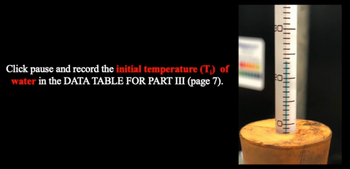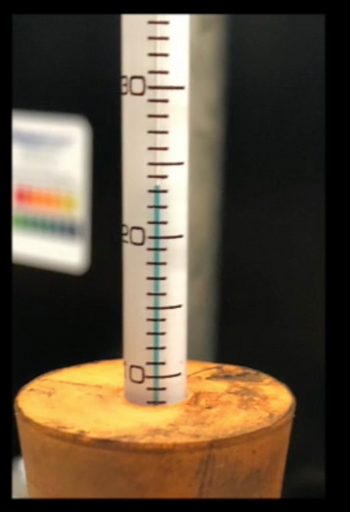
Chemistry
10th Edition
ISBN: 9781305957404
Author: Steven S. Zumdahl, Susan A. Zumdahl, Donald J. DeCoste
Publisher: Cengage Learning
expand_more
expand_more
format_list_bulleted
Concept explainers
Question
Can you help me with initial temperature (Ti) of water? I struggled with the measurement of the thermometer.

Transcribed Image Text:Click pause and record the initial temperature (T) of
water in the DATA TABLE FOR PART III (page 7).
BO
H

Transcribed Image Text:80
hund
Expert Solution
This question has been solved!
Explore an expertly crafted, step-by-step solution for a thorough understanding of key concepts.
Step by stepSolved in 2 steps

Knowledge Booster
Learn more about
Need a deep-dive on the concept behind this application? Look no further. Learn more about this topic, chemistry and related others by exploring similar questions and additional content below.Similar questions
- A student sets up the following equation to convert a measurement. (The ? stands for a number the student is going to calculate.) Fill in the missing part of this equation. Note: your answer should be in the form of one or more fractions multiplied together. 0.080 mmol - °C 0 = ? mol. °C 10 0.0 X μ DOarrow_forwardCalculate the volume in liters of a 1.41g/dL copper(II) sulfate solution that contains 459.g of copper(II) sulfate CuSO4. Be sure your answer has the correct number of significant digits.arrow_forward(CONTINUED ON NEXT PAGE) 4. Let's say that the full volume of your flask is 325 ml. You heat the flask of air in a hot water bath at 89.0°C according to your thermometer. You then inverti into the cold water bath at 5.0°C Water enters the flask as the volume of the gas shrinks. a) Theoretically, what should the volume of the gas be after it sits in the cold water bath? b) You find that during your experiment that 65.0 mL of water has entered the flask. What is the experimental volume of the gas? c) What is your percent error for this measurement?arrow_forward
- What steps do I take to convert .00368 x 103 kJ to microJ?arrow_forwardA chemist prepares a solution of aluminum chloride (AIC13) by weighing out 21.89 g of aluminum chloride into a 200. mL volumetric flask and filling the flask to the mark with water. Calculate the concentration in g/dL of the chemist's aluminum chloride solution. Be sure your answer has the correct number of significant digits.arrow_forwardWe are doing an experiment on measuring the temperature. We are to measure the temperature of hot water (measure it initially, then wait for 10 minutes then measure again). Additionally, we are to measure the temperature of another water before and after putting ice (measure initially then measure 3 times [every 5 minutes] for 15 minutes). My question are: What law or principles of chemistry could be applied in this experiment? Should we expect the temperature of the hot water to drop? why? Should we expect the temperature of the water to rise or drop after putting the ice? why?arrow_forward
- At certain pressures, ClF forms a solid that sublimes when heated. Using a few words and a simple diagram, explain what is happening when ClF sublimes upon heating. Be sure your answer describes the differences in the two states of matter.arrow_forward2-arrow_forwardsolution to a reaction flask. Calculate the mass in kilograms of barium acetate the A chemist adds 450.0 mL of a 1.0 mol/L barium acetate (Ba(C,H,O, chemist has added to the flask. Round your answer to 2 significant digits. | kg x10arrow_forward
arrow_back_ios
arrow_forward_ios
Recommended textbooks for you
 ChemistryChemistryISBN:9781305957404Author:Steven S. Zumdahl, Susan A. Zumdahl, Donald J. DeCostePublisher:Cengage Learning
ChemistryChemistryISBN:9781305957404Author:Steven S. Zumdahl, Susan A. Zumdahl, Donald J. DeCostePublisher:Cengage Learning ChemistryChemistryISBN:9781259911156Author:Raymond Chang Dr., Jason Overby ProfessorPublisher:McGraw-Hill Education
ChemistryChemistryISBN:9781259911156Author:Raymond Chang Dr., Jason Overby ProfessorPublisher:McGraw-Hill Education Principles of Instrumental AnalysisChemistryISBN:9781305577213Author:Douglas A. Skoog, F. James Holler, Stanley R. CrouchPublisher:Cengage Learning
Principles of Instrumental AnalysisChemistryISBN:9781305577213Author:Douglas A. Skoog, F. James Holler, Stanley R. CrouchPublisher:Cengage Learning Organic ChemistryChemistryISBN:9780078021558Author:Janice Gorzynski Smith Dr.Publisher:McGraw-Hill Education
Organic ChemistryChemistryISBN:9780078021558Author:Janice Gorzynski Smith Dr.Publisher:McGraw-Hill Education Chemistry: Principles and ReactionsChemistryISBN:9781305079373Author:William L. Masterton, Cecile N. HurleyPublisher:Cengage Learning
Chemistry: Principles and ReactionsChemistryISBN:9781305079373Author:William L. Masterton, Cecile N. HurleyPublisher:Cengage Learning Elementary Principles of Chemical Processes, Bind...ChemistryISBN:9781118431221Author:Richard M. Felder, Ronald W. Rousseau, Lisa G. BullardPublisher:WILEY
Elementary Principles of Chemical Processes, Bind...ChemistryISBN:9781118431221Author:Richard M. Felder, Ronald W. Rousseau, Lisa G. BullardPublisher:WILEY

Chemistry
Chemistry
ISBN:9781305957404
Author:Steven S. Zumdahl, Susan A. Zumdahl, Donald J. DeCoste
Publisher:Cengage Learning

Chemistry
Chemistry
ISBN:9781259911156
Author:Raymond Chang Dr., Jason Overby Professor
Publisher:McGraw-Hill Education

Principles of Instrumental Analysis
Chemistry
ISBN:9781305577213
Author:Douglas A. Skoog, F. James Holler, Stanley R. Crouch
Publisher:Cengage Learning

Organic Chemistry
Chemistry
ISBN:9780078021558
Author:Janice Gorzynski Smith Dr.
Publisher:McGraw-Hill Education

Chemistry: Principles and Reactions
Chemistry
ISBN:9781305079373
Author:William L. Masterton, Cecile N. Hurley
Publisher:Cengage Learning

Elementary Principles of Chemical Processes, Bind...
Chemistry
ISBN:9781118431221
Author:Richard M. Felder, Ronald W. Rousseau, Lisa G. Bullard
Publisher:WILEY